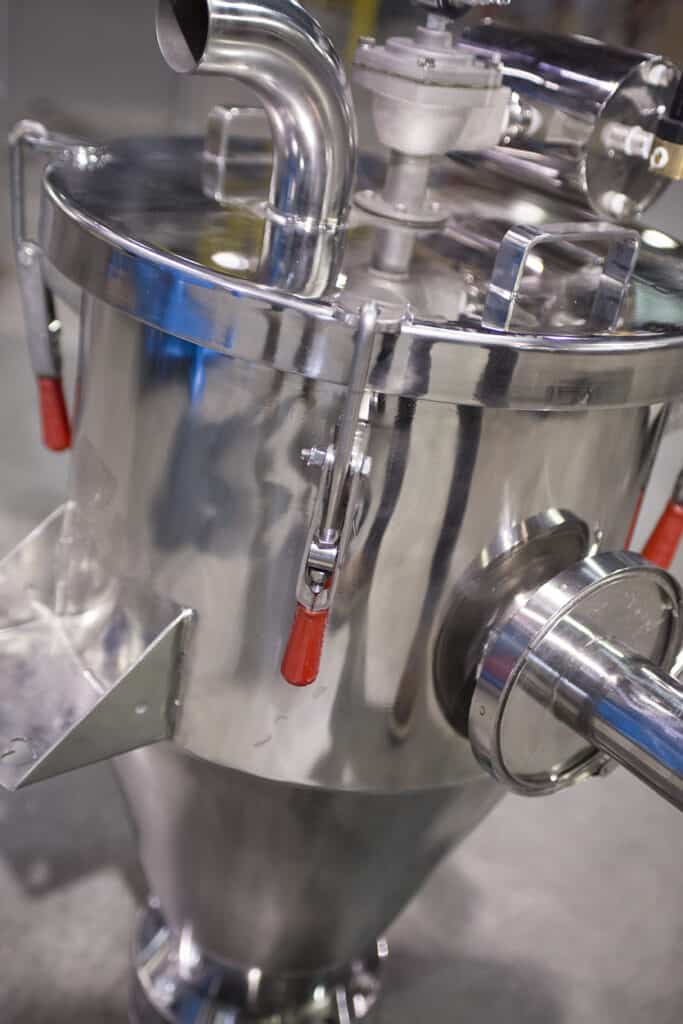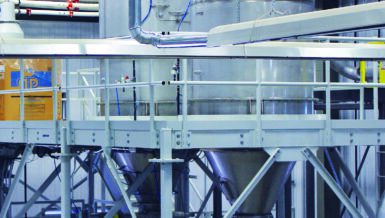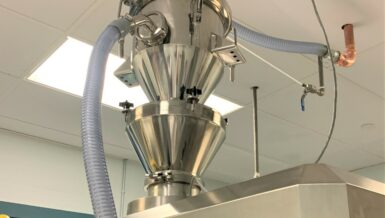The complexity of factors considered when designing vacuum conveying systems can bring about the notion of expensive custom systems that can take months of design before a solution reaches the plant floor. Or perhaps you imagine older, off-the-shelf systems that were designed for undemanding bulk solids transfer and limited powder applications.
In reality, today’s turnkey pre-engineered vacuum conveying packages descend from a gene line of custom-engineered solutions and satisfy about 80 percent of the challenges faced when conveying powders and bulk solids, including combustible dust. The other 20 percent of challenges may need custom or auxiliary equipment to achieve an organization’s material handling needs.
All vacuum conveying systems consist of five basic components: a pickup point, a vacuum receiver, a vacuum producer, a control panel, and conveying tubing, all simple stuff, right? The complexity surfaces when you consider that each component has a variety of available options that influence the parameters of the next. The art of vacuum conveying manifests in the careful orchestrating of those components to create a system that provides application-specific solutions. Pre-engineered solutions are birthed from custom first-time solutions that advanced the science of vacuum conveying.
Variety in pre-engineered vacuum conveying systems
Examples of custom-engineered systems that have been adapted into application-specific, pre-engineered packaged systems include tablet press loading systems, direct-charge blender loading for food, pharmaceuticals, chemicals, and metal powder recovery systems for additive manufacturing.
In addition to these, modern general duty pre-engineered conveying system packages include component options for vacuum producers, conveyor mounting, standard or sanitary design, filter media possibilities, interior and exterior finishes, and flexible utility alternatives to complement plant utility requirements. These package choices provide a broader range of use across the food, pharmaceutical, chemical, plastics compounding, and metal forming and finishing industries and are adaptable when conditions such as business needs or materials change.
Shopping for a system
Purchasing a pre-engineered vacuum conveyor isn’t like purchasing a widget from a website where you just click on a product and it ships to you. Because each organization and plant have unique requirements, consultation with a pneumatic conveying expert is still necessary to ensure a pre-engineered product will work as intended without costly surprises. Some common custom engineering requirements are related to available space, material characteristics, integration with existing equipment, and level of automation desired.
Although pre-engineered vacuum conveying systems are designed to address common powder conveying challenges experienced in a range or class of materials or for materials with a range of characteristics, some powders require the addition of auxiliary or accessory equipment making that.
Fine powders with low bulk density, such as fumed silica and carbon black, present their own set of challenges. They may require more filtration and thus a larger vacuum receiver, which may be larger than what’s available in a packaged system.
Non-free-flowing powders, like those with high fat content, generally require the most equipment modifications. However, there’s a plethora of methods used to handle non-free-flowing powders that are incorporated into some pre-engineered systems. For example, specialized finishes, oversized receiver discharge openings, 70 degree discharge cones, and coneless (straight-walled) vacuum receivers, like the one shown in Figure 1, can help improve material flow and eliminate the need for custom external flow promotion.
Today, the wide range of available systems helps organizations reap the benefits of using vacuum conveying equipment, such as dust containment, workstation ergonomics, material segregation prevention, decreased loading and cleaning downtime, material mishandling and spill prevention, and increased throughput. Sometimes, however, the level of automation needed, plant design, or integrating with existing equipment prevents the use of pre-engineered systems or requires incorporating auxiliary equipment with these systems.
A system for every application
The key to successful powder and bulk solids processing is finding what works for your application. Sometimes, even pre-engineered systems call for more custom solutions. For example, since blenders are used across a wide range of industries, from food and pharmaceuticals to cosmetics and chemical blending, a direct-charge blender loading vacuum conveying system, like the one shown in Figure 2, is an ideal pre-engineered package to use as an example of when unique conditions may require more custom solutions. Direct-charge blender loading systems are designed specifically for the direct-charge loading of blenders, mixers, reactors, and any vessel capable of withstanding a vacuum. With this type of conveying system, a facility’s blender or mixer acts as the primary vacuum receiver but power sources, filters, controls, and blender covers with a product inlet and vacuum outlet can be supplied as a combined package. Pre-engineered systems are equipped with a pickup wand to suck materials from vessels into the conveying line, but can also accommodate feed bins, bag-dump stations, or bulk bag unloaders.

When a pharmaceutical, cosmetic, and flavorings toll processor needed to accommodate industry changes in how bulk materials were transported, the company realized their existing method no longer worked. After researching vacuum conveying options, the processor decided that the pre-engineered direct-charge blender loading system was the ideal solution because it was designed to address specific needs of blender loading while eliminating the need for a conventional vacuum receiver and avoiding product waste. Because many of the processor’s customers provided bulk powders in 25-pound bags, using a wand to suck material from vessels into the conveying line wasn’t a viable option, so the company added a bag-dump station, like the one in Figure 3, that fed material into the direct-charge blender loading system. This addition allowed operators to lift bags onto the bag-dump station grate, cut a slit in the bag, and then turn the bag over so that the material would fall by gravity into the conveying line.
Ergonomic bag-dump stations reduce spillage during bag loading by using negative pressure to suck fugitive dust into the system before the dust has a chance to enter the air around the operator and plant environment, reducing housekeeping costs, product loss, and risk.
As with most vacuum conveying and support equipment, including pre-engineered systems, bag-dump stations have the ability to be modified or enhanced. For instance, if material is not free-flowing, then a screw discharger may be added to the bag-dump station to help move the material into the conveying line.
The ability to modify or enhance pre-engineered systems came to fruition when the same toll blender needed a solution for a new customer’s blended product that seemed impossible to convey into bulk bags. The solution to getting the clay-like material to convey into bulk bags was a system that included fitting a pickup hopper into the space where fiber bins normally sat. The pickup hopper was equipped with a free-flowing screw discharger designed to handle sticky powders. From the hopper, the material was metered into the conveying line that led to a vacuum receiver where it was discharged into a bulk bag loading station and then released into a fresh bulk bag.
Adapting equipment to business needs
Challenging powders sometimes need custom solutions, but even when powders behave well with systems, the necessity to customize pre-engineered vacuum conveying systems can arise from growth and automation needs.
When steady growth at a thermal spray coating manufacturer necessitated moving to a large-scale mixer to stay ahead of orders, the company needed to find a way to load six 160-pound barrels into a blender 6 or 7 feet off the ground. After years of manually loading small 160-pound batches into a 55-gallon rotary drum mixer, the manufacturer knew that the new system had to be automated.

After researching automated systems of material delivery to blenders, the coating manufacturer chose a pre-engineered direct-charge blender loader. In addition to loading the blender, the spray coating manufacturer also wanted a conveying system to transfer finished product from the blender into boxes all while staying within a specific budget.
Rather than purchasing two vacuum conveying systems — one to convey material into the blender and another to move blended material from the blender into packages — a dual-purpose system was proposed. This dual-purpose system, like the one shown in Figure 4, would use the same conveyor system to load and unload the blender. After materials were blended, the same vacuum conveying system used to load the blender was connected to the bottom of the blender, and the material was metered by volume into a collection hopper. When the hopper reached a predetermined level, the system stopped conveying and dumped the material into a box.
Limitations to modifications
Because pre-engineered systems come from the DNA of custom-engineered solutions, adaptations can be made to fit the unique needs of manufacturers and processors. However, there are times when pre-engineered systems don’t stretch into areas where more technical expertise and experience is required, such as facility constraints. While pneumatic conveying systems have a small footprint compared to other material-handling methods, even the smallest conveying system needs at least 30 inches of headroom above processing or packaging equipment.
In situations where headroom is not adequate for pre-engineered vacuum conveying systems, positive pressure systems, cyclones, filterless material receivers, or scaling valves that divert material directly into hoppers in low clearance areas are some ways to get around headroom constraints. When companies have severe height restrictions, vacuum receivers are sometimes located outside. When possible, adaptations can be made to conveying equipment, such as modifying filter lids, to enable systems to fit within a specific space.
Every vacuum conveying system design, whether it’s a sophisticated custom-engineered system or pre-engineered packaged system, begins with a blank page because each organization and plant have unique requirements. Consulting with a vacuum conveyor expert early in the buying process ensures that manufacturers and processors will reap the long lifespan and many benefits of vacuum conveying systems, including maintenance efficiency, which begins at the design stage.










































